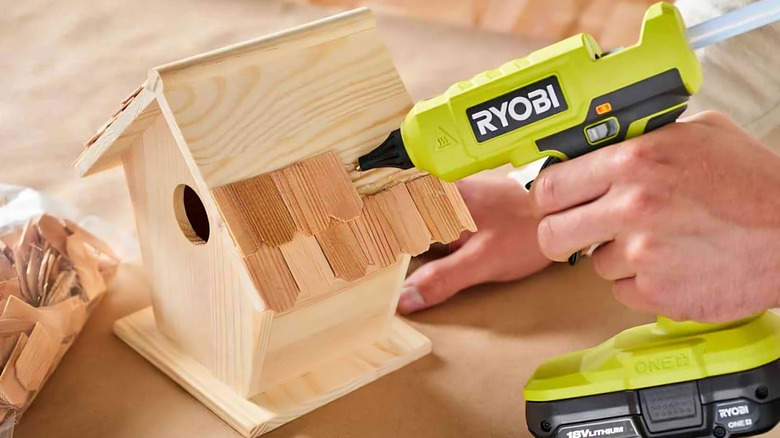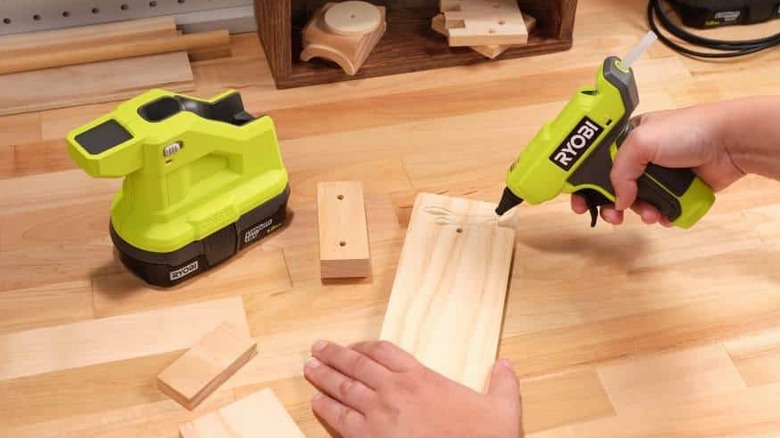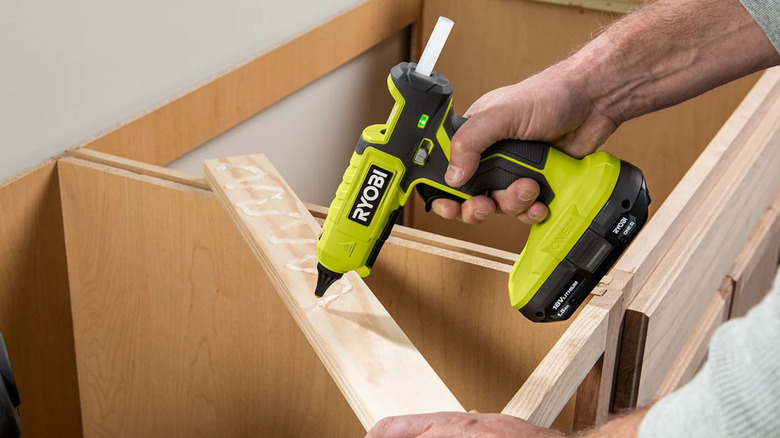How To Choose The Best Ryobi Glue Gun For Your DIY Project
We may receive a commission on purchases made from links.
When picking out a Ryobi glue gun, you'll want to take into account what projects you do regularly. Do you do DIYs that require stronger adhesives, or do you keep it simple, like using your hot glue gun to secure decor on your shelves? Ryobi offers high-temp glue guns for heavy-duty adhesion, dual-temperature ones used for versatile applications, and compact versions for quick and easy craft work. Each model runs off of Ryobi's ONE+ battery system, heating up in about three minutes and providing the freedom to work anywhere without stressing about finding an outlet. The dual temperature model can go from a low of 248 degrees to a high of 320 degrees Fahrenheit, which is great for repairs that require maximum bonding, but it may be too much for delicate materials.
Both the regular and dual-temp models accept the standard half-inch full-size glue sticks and can be used with interchangeable nozzles, which are sold separately. The compact model uses the smaller mini glue sticks and can reach temperatures of up to 365 degrees Fahrenheit. Before choosing, you should consider where you'll be working most often. If you have a dedicated working space, then the compact model would fit nicely, and the charger stand will help keep it organized. However, if you know you'll need your glue gun on the go, the regular models might be your best bet. Battery life on the standard models typically lasts for about three and a half hours of continuous use, while the compact version only goes for up to five minutes when it's removed from its base.
The perfect glue gun for crafts, repairs, and light DIY
For craft enthusiasts working with more delicate materials like fabric, foam, or thin plastics, the Dual-Temp Glue Gun is an excellent choice. Its lower 248-degree setting prevents melting or warping of sensitive materials while still creating a good bond for whatever you're crafting. If mixed with the precision nozzle, you'll be able to get cleaner applications along edges and corners. If you're taking on some heavier household projects like cracked plastic items or wobbly furniture legs, you can easily switch to the 320-degree setting mixed with high-temp glue sticks to help provide some extra adhesiveness.
The dual temp or the standard glue gun model is great for DIYers who love doing hot glue hacks around the house. Locking down loose carpet edges, hiding wires under your desk, or fixing outdoor decorations without having to search for an outlet makes it a great choice. The fast heat up makes them ideal for fix-it-and-move-on projects. However, if you tend to keep it simple and have a dedicated workspace, the compact glue gun would be your best choice. It can reach higher temperatures when needed and is ready to work at all times, making it perfect for crafts that require little dabs of hot glue throughout.
Choosing the right glue gun for tougher jobs
Construction and woodworking projects require something a little more beefy than the compact version would be able to provide, and Ryobi's standard glue gun model is a great choice. Its consistent high-temp output creates stronger bonds for fixing damaged wooden furniture trim or repairing joints quickly and easily. All things that may fail under stress with a lower temperature option. Although hot glue might not be the best choice for it, the standard glue gun can also do a great job with more detailed outdoor projects like tabletop tile mosaics or stone laying, and the thinner tips could easily get in between grout lines.
The standard glue gun also works well in projects with metal and non-metal, like attaching sheet metal to a non-metal surface, as long as you use high-strength glue sticks. While hot glue isn't going to be able to hold heavy metal parts, it's more than capable of handling cosmetic tasks like adding metal embellishments or securing wires. Ryobi's glue guns are also compatible with specialty glue sticks, like those designed for non-porous surfaces like glass or ceramics.
If you are taking on bigger projects, consider grabbing an extra battery to avoid any downtime while waiting for a recharge. Regardless of what model you choose, proper maintenance will be important to extend the life of your tool. Be sure to clean your nozzles regularly and always store the gun upright on a silicone mat to prevent clogs.


